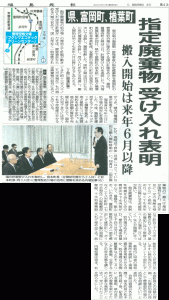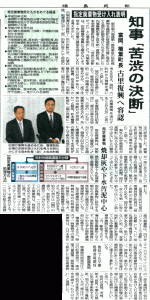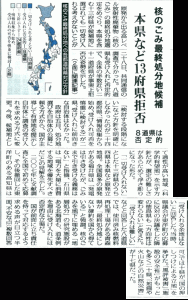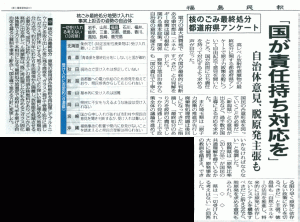Original Japanese written by staffer
The English below translated from the original Japanese by Heeday
The English translation edited by Rev. Dr. Henry French, ELCA
(Based on articles from the December 4th, 2015 edition of the Fukushima Minpo newspaper)
▼Click each image and read the caption.
The local governments of Fukushima Prefecture and Tomioka and Naraha Towns have decided to accommodate the Japanese government’s plan to bury the “specified waste” from TEPCO’s Fukushima Daiichi Nuclear Power Plant (NPP) in controlled disposal sites in Tomioka Town and elsewhere, Fukushima Prefecture. The burying is expected to begin in June 2016, at the earliest.
Here, “specified waste” refers to waste containing 8,000 becquerels or more of radioactive cesium per kg (per 2.2 lb.), and which has been specified by Japan’s Minister of the Environment as such waste. Where should such waste go? In compliance with the nation’s Act on Special Measures Concerning the Handling of Pollution by Radioactive Materials, such waste is categorized according to its radioactive substance contents, and each category is buried in a different site. Waste containing 8,000 becquerels or more and up to 100,000 becquerels of radioactive cesium per kg (per 2.2 lb.) are to be buried in “Fukushima Eco Tech Clean Center,” a controlled disposal site located in Tomioka Town. High-density waste, containing more than 100,000 becquerels, needs to be kept within a containment disposal facility surrounded by concrete walls. Since there is currently no such facility in Fukushima Prefecture, such waste from Fukushima Daiichi are to be buried in storage dedicated to such waste at an interim storage facility to be built in Okuma and Futaba Towns. Meanwhile, the contaminated soil collected in the decontamination work is not treated as “specified” and is to be kept in such interim storage facilities regardless of its density of radioactive substances.
(*1 “Becquerel” is a unit of measurement of radioactivity. If an atom’s nucleus decays and emits radiation every one second, it is counted as “1 becquerel.” Now, “radioactivity” is the capability to emit radiation, and “becquerel” measures such capability, while “sievert” (Sv) is about the radiation dose a human is exposed to. Where there is a single source of radiation (becquerel), the actual radiation dose people are exposed to (sievert) from the source can differ, depending on situational conditions—the kind of the radioactive substance in the source, the distance between the source and a person, the effectiveness of the shield (if any) between the two, and so on. Meanwhile Japan’s Food Sanitation Act defines some tentative regulations on radioactive substances contained in foods. 1kg (2.2 lb.) of drinking water or milk must not contain more than 200 becquerels of radioactive iodine. 2,000 becquerels for vegetables. For radioactive cesium, no more than 200 becquerels per 1kg (2.2 lb.) of drinking water or milk, and no more than 500 becquerels per the same weight of vegetables, cereal, meat, eggs, etc. The Act demands of municipalities that any foods containing radioactive substances in excess of those limits should not be consumed by humans.)
While there is a national plan to build storage facilities for “specified waste” in six prefectures of Japan, Fukushima has become the first to accommodate such a facility. In the other targeted prefectures, many residents around a planned facility site are opposed to the plan, making it lag behind schedule. Fukushima’s decision to accept the national plan might provide a model of consensus building, and many are concerned over such “consensus” building.
(Based on articles from the November 29th, 2015 edition of the Fukushima Minpo newspaper)
▼Click each image and read the caption.
Turning our eyes to final disposal facilities of high-level radioactive substances (“nuclear waste”), the Fukushima Minpo newspaper reported, in its November 29, 2015 edition, on a survey conducted by Kyodo News with all of the 47 prefectural governments of Japan about such facilities. None of the 47, including Fukushima, is willing to accommodate such a final disposal facility.
The survey found 13 prefectures replying “no intention to accommodate (such a facility) at all,” and the 13 included Fukushima. Of them, four are currently accommodating a NPP or more. Eight others said “it is hard to accommodate (such a facility),” while 24 others responded with no policy about such facilities. The Ministry of Economy, Trade and Industry and the Nuclear Waste Management Organization of Japan (NUMO) are planning to announce some “scientifically” hopeful candidate sites, i.e., sites considered to be “scientifically” acceptable for accommodating a final disposal facility. In the current situation, however, such an announcement can invite harsh objections from the citizens of those “candidate” sites.
So far, Japan’s national government has been developing nuclear power policies while postponing decisions on what to do with radioactive waste management. This is the time when we should decide what to do with the final disposal of nuclear waste. Every municipality, as well as every citizen, needs to consider this grave issue. Considering this issue can help many reconsider whether nuclear power is truly necessary or not, which would lead to reconsideration of the energy policies of the Japanese government.




